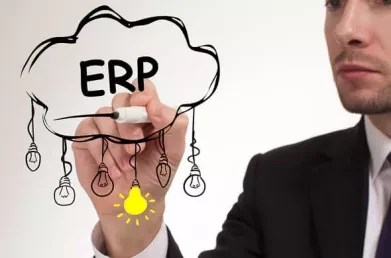Avoiding ERP Selection Bias 1: "It must be/can’t be SAP"
As independent ERP consultants, at Lumenia we have guided many organisations through ERP selection and procurement processes. These projects vary in size, scope, sector and geography and so we have seen all of the leading ERP solutions evaluated and selected over the years.
Starting into a selection cycle we often encounter definite biases in the selection team or the approval team. This series of blogs addresses the two that we encounter most frequently.
-
It must be/can’t be SAP.
-
Microsoft Dynamics is the obvious choice for us because we already have other Microsoft products.
This first bias – It must be or cannot be SAP – usually comes from one of the most senior stakeholders – usually one that is not very engaged with the process (the first warning sign). It tends to be driven by either ego or fear.
The stakeholder with the ego driven version of this bias nominally encourages their team to have an open and inclusive selection process but makes it clear that the outcome should be to select SAP. SAP is generally considered the market leader and the most complete ERP solution. This stakeholder wants to have what they perceive to be the best - the Rolls Royce or Ferrari if you will. That impulse might have no relationship to their budget or the roads they can drive it on!
The stakeholder with the fear driven version of this bias has heard the horror stories about failed SAP implementations, either in the media or from personal contacts. “Anything but SAP” they think, “I couldn’t bring that on my organisation”.
Both versions of this bias are informed by a smidgen of truth. However, both miss much bigger truths and contexts that might mean the bias is driving them towards a sub-optimal, or maybe even disastrous, selection decision.

Let’s consider why…
SAP is the market leader so it must be the best, and I need the best!
SAP is the market leader in ERP systems in most published analyses. That statement becomes a bit more questionable when you look at wider Enterprise Software space and Oracle, IBM and others might challenge it. SAP dominates at the large multi-national corporation level and is strongly represented in mid-size organisations on both sides of the Atlantic. It is used in organisations operating in most, if not all, sectors of the economy. It has been around a while and is a mature product set. It has grown both organically and by acquisition. It has a large ecosystem of skilled partners, sub-contractors and users, meaning that people with SAP skills, while in demand, are available.
A safe choice then? Well, sometimes. Consider the following:
- SAP’s flagship ERP product, S/4 HANA, has broad and deep functional capability. That means implementing it can be complex. There are lots of possible configurations and your consultants must work with you to find the right ones for you. That flexibility is great, if you need it. But, you may not. A solution with less breadth of functionality and fewer configuration options may be quite suitable for your needs.
- Are you buying a sledgehammer to crack a nut? If the bulk of your line of business processes are carried out in specialist systems and you only need to implement finance or some limited group of process areas, then a more basic solution with more limited functional reach may be quite sufficient, and more cost effective.
- Is your organisation mature enough to implement very controlled and standardised business processes? Arguably all ERP solutions require a level of process control and standardisation in order to be effective. However, this is more true for SAP than for many others. Building in that level of control is a big selling point for some organisations but it does bring a systems management overhead that not every organisation is ready for. If not well managed it could reduce agility in key business processes and be counter-productive.
- Do you have a very specific set of requirements in a part of the business or in a specific business process area that may be better served by a specialist best-of-breed solution? While SAP has strong functionality in most business process areas and you can potentially find a way to address most requirements with it, it can be the case that a limited set of requirements may be more effectively addressed by a smaller more focused solution.
- Can you afford it? S/4 HANA is more expensive than many solutions, both for up-front spend and TCO. There definitely are circumstances where it is not the most expensive solution to an organisations’ needs but it is likely to be at the upper end of most comparisons. That may be fine, as long as it delivers most benefits. However, it rarely hits a competitive price point for much smaller organisations.
See also ERP VS Best of Breed: What You Need to Consider
The above are some reasons why SAP might not be the most suitable option for every organisation and an ego driven SAP bias should be tempered, what follows are some reason why it should not always be disregarded.
I’ve heard the horror stories. There is no way we are implementing SAP!
The fear driven version of the bias is based on widely reported stories of SAP project failures costing organisations millions and sometimes ending up in court.
These cases exist. But ERP projects are difficult and every ERP vendor has failed projects. If SAP is the market leader it stands to reason that there might be more failed projects as well as successful ones. If it is the most widely used ERP in the largest organisations then of course the losses caused by failed projects will be higher and the media attention will be stronger.
ERP projects are complex transformation projects. They don’t fail because of the software. They fail because of bad governance, insufficient resources, unclear scope, poor project management, poor change management and a host of reasons that have more to do with people and organisation (often internal) than with SAP or any other software solution.
A second thing worth considering if a stakeholder holds this bias is that there is more than one SAP ERP solution. The stakeholder might rightly feel that S/4 HANA is too big and complex for their organisation, but SAP also has Business ByDesign and Business One. Both aimed at smaller organisations. ByDesign and Business One projects also need good governance, sufficient and suitable resources and all of the other things mentioned above (as do all ERP projects) but they are typically simpler projects and may be more suitable for some.
SAP may still not be the right answer for your organisation but being aware of the reasons why these biases may drive you in the wrong direction is worth considering.
An independent and product agnostic selection process should avoid such biases.
Even with an effective selection process you are not ready for implementation unless you have prepared your organisation to avoid the typical reasons for failure mentioned above. Effort should not be spared preparing the organisation for the implementation as well as the purchase.
Part 2, of this series looks at a common selection bias relating to Microsoft’s Dynamics product range, Avoiding ERP Selection Bias 2.
Learn more about Lumenia’s independent ERP Selection services.
Learn more about Lumenia’s ERP Readiness workshops
This blog was written by Ian O'Toole, Managing Partner at Lumenia. For further information please send an email to Ian O'Toole


